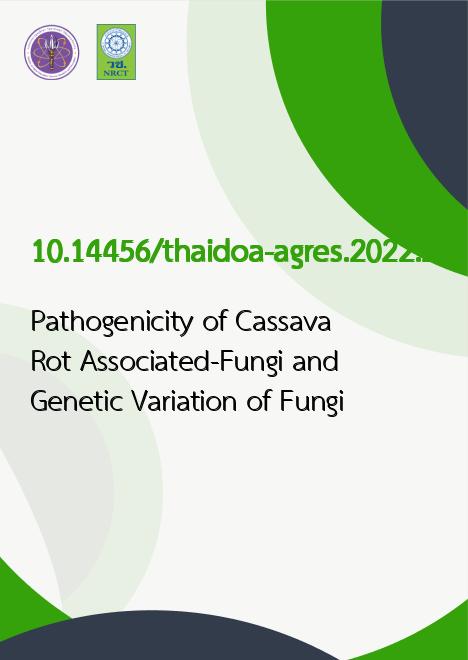
|
Pathogenicity of Cassava Rot Associated-Fungi and Genetic Variation of Fungi |
|---|---|
| รหัสดีโอไอ | |
| Creator | Nuttiya Phongsuthat |
| Title | Pathogenicity of Cassava Rot Associated-Fungi and Genetic Variation of Fungi |
| Contributor | Napaporn Phankamolsil, Phanuwat Moonjuntha, Suwaluk Amawan, Wanwilai Intanoo, Jintana Unartgam |
| Publisher | Department of Agriculture |
| Publication Year | 2565 |
| Journal Title | Thai Agricultural Research Journal |
| Journal Vol. | 40 |
| Journal No. | 3 |
| Page no. | 238-250 |
| Keyword | Cassava, root rot, tuber rot, stem rot, ISSR |
| URL Website | https://at.doa.go.th/journal |
| Website title | Thai Agricultural Research Journal |
| ISSN | 0125-8389 |
| Abstract | Cassava (Manihot esculenta Crantz) is one of the important economic crops of Thailand. The root rot, tuber rot and stem rot diseases caused by fungal pathogens are the main problems of cassava production. The purposes of this research were to study the pathogenicity of rot diseases fungi and to evaluate their genetic variability. Cassava diseases survey was conducted, infected roots, tubers and stems were collected. Soils around diseased plants were sampled at 3 depth levels i.e. 0-20, 20-40 and 40-60 centimeters. Morphological characteristics-based identification was done and pathogenicity test was observed in Rayong 9 variety by inoculating with 12 isolates of Fusarium spp., Pythium spp., and Neoscytalidium sp. Results revealed that Fusarium spp. and Neoscytalidium sp. were related to disease occurrence on Rayong 9 variety after 5 months of inoculation. When the isolates of Fusarium spp. and Neoscytalidium sp. were analysed at ITS rDNA region and nucleotide sequences of RPB2 and Tef -1? genes for Fusarium species identification, results indicated that the isolates were identified as N. dimidiatum, F. incarnatum and F. solani. Moreover, the genetic variability was observed by ISSR markers in N. dimidiatum (20 isolates), F. incarnatum (16 isolates), and F. solani (13 isolates). Results showed that there were variations both within fungal population and among populations from different cassava fields. |